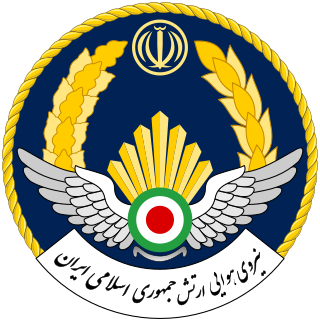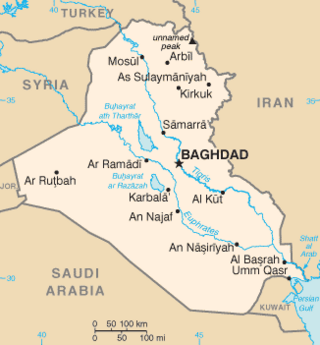
The Rockwell International Guided Bomb Unit 15 is an unpowered glide weapon used to destroy high-value enemy targets. It was designed for use with F-15E Strike Eagle, F-111 'Aardvark' and F-4 Phantom II aircraft. The GBU-15 has long-range maritime anti-ship capability with the B-52 Stratofortress.
This is a list of aviation-related events from 1984.

The Dassault Mirage F1 is a French fighter and attack aircraft designed and manufactured by Dassault Aviation. It was developed as a successor to the Mirage III family.

The Islamic Republic of Iran Air Force is the aviation branch of the Islamic Republic of Iran Army. The present air force came into being when the Imperial Iranian Air Force was renamed in 1979 following the Iranian Revolution. The IRIAF was heavily involved in the Iran–Iraq War, carrying out major operations like Operation Kaman 99, Operation Sultan 10, the H-3 airstrike, and the first attack on a nuclear reactor in history, Operation Scorch Sword. As a result of eight years of aerial combat in that conflict, the IRIAF has the second highest claimed number of fighter aces in the region, exceeded only by the Israeli Air Force; as many as seven IRIAF pilots claimed more than six kills, mostly achieved in the F-14 Tomcat. Veterans of the Iran–Iraq War would go on to form the core of the IRIAF command.

The McDonnell DouglasF-15E Strike Eagle is an American all-weather multirole strike fighter derived from the McDonnell Douglas F-15 Eagle. The F-15E was designed in the 1980s for long-range, high-speed interdiction without relying on escort or electronic-warfare aircraft. United States Air Force (USAF) F-15E Strike Eagles can be generally distinguished from other US Eagle variants by darker aircraft camouflage, conformal fuel tanks (CFTs) mounted along the engine intake ramps and a tandem-seat cockpit.
This is a list of aviation-related events from 1991.

Suppression of Enemy Air Defenses (SEAD, pronounced ), also known in the United States as "Wild Weasel" and (initially) "Iron Hand" operations, are military actions to suppress enemy surface-based air defenses, including not only surface-to-air missiles (SAMs) and anti-aircraft artillery (AAA) but also interrelated systems such as early-warning radar and command, control and communication (C3) functions, while also marking other targets to be destroyed by an air strike. Suppression can be accomplished both by physically destroying the systems or by disrupting and deceiving them through electronic warfare. In modern warfare, SEAD missions can constitute as much as 30% of all sorties launched in the first week of combat and continue at a reduced rate through the rest of a campaign. One quarter of American combat sorties in recent conflicts have been SEAD missions. Despite generally being associated with aircraft, SEAD missions may be performed using any means, including through actions by ground forces.

The Iraqi Air Force is the aerial warfare service branch of the Iraqi Armed Forces. It is responsible for the defense of Iraqi airspace as well as the policing of its international borders. The IQAF also acts as a support force for the Iraqi Navy and the Iraqi Army, which allows Iraq to rapidly deploy its military. It is headquartered in Baghdad; the current commander is Lieutenant Gen. Shihab Jahid Ali.

The Kuwait Air Force is the air arm of the Armed Forces of Kuwait. The Air Force headquarters is located at Abdullah Al-Mubarak Air Base, with the remaining forces stationed at Air Defense Brigades, Ali Al Salem Air Base and Ahmad al-Jaber Air Base. The Kuwait Air Force numbers approximately 2,500 officers and enlisted personnel.

Opération Daguet was the codename for French operations during the 1991 Gulf War. 18,000 members of the French Armed Forces were deployed during the conflict and they represented the second largest European contingent. Operating on the left flank of the US XVIII Airborne Corps, the ground component of the French force, named Division Daguet, was formed in September 1990 in Saudi Arabia as part of France's contribution to Operation Desert Shield. France also deployed several combat aircraft and naval units. Opération Daguet was commanded by Army general Michel Roquejeoffre.

Prince Sultan Air Base is a military air base located in the closed-city of Al Kharj, Saudi Arabia.
The Grumman F-14 Tomcat has served with the United States Navy and the Imperial Iranian Air Force, then the Islamic Republic of Iran Air Force after 1979. It operated aboard U.S. aircraft carriers from 1974 to 2006 and remains in service with Iran. In-depth knowledge of its service with Iran is relatively limited.

Operation Southern Watch was an air-centric military operation conducted by the United States Department of Defense from August 1992 to March 2003.

Operation Desert Storm, the combat phase of the Gulf War, began with an extensive aerial bombing campaign by the air forces of the coalition against targets in Iraq and Iraqi-occupied Kuwait from 17 January 1991 to 23 February 1991. Spearheaded by the United States, the coalition flew over 100,000 sorties, dropping 88,500 tons of bombs, widely destroying military and civilian infrastructure. The air campaign was commanded by United States Air Force (USAF) Lieutenant General Chuck Horner, who briefly served as Commander-in-Chief—Forward of U.S. Central Command while General Norman Schwarzkopf was still in the United States. The British air commanders were Air Chief Marshal Andrew Wilson and Air Vice-Marshal Bill Wratten. The air campaign had largely finished by 23 February 1991 with the beginning of the coalition ground offensive into Kuwait.
The General Dynamics F-16 Fighting Falcon has served the United States and the air arms of 25 other nations. Over 4,400 F-16s have been sold.
During the 1991 Gulf War and subsequent operations in no-fly zones over Iraq, Coalition air forces faced the Iraqi Air Force (IQAF), the fourth largest air force in the world at the time. In the opening days of the war, many air-to-air engagements occurred, between Iraqi interceptors and a variety of different Coalition aircraft.

The H-3 airstrike was a surprise air attack by the Iranian Air Force during the Iran–Iraq War on 4 April 1981 against the Iraqi Air Force's H-3 Air Base in western Iraq. The Iranians destroyed at least 48 Iraqi aircraft on the ground with no losses of their own. Based on the results achieved, it is considered one of the most successful raids in the history of aerial warfare.

Operation Sultan 10 was an operation of the Islamic Republic of Iran Air Force (IRIAF) on 29 October 1980, at the beginning of the Iran–Iraq War. In this operation, six F-4E Phantom IIs from IRIAF's 32nd and 33rd Squadrons took part in an attack on the Al-Hurriah Airbase near Mosul in Saddam Hussein's Iraq.
Operation Samurra was an operation by the Iraqi Air Force (IQAF) during the Gulf War to decisively engage McDonnell Douglas F-15C Eagle fighters from the United States Air Force (USAF) using Mikoyan-Gurevich MiG-25 interceptors, and break the "wall" of F-15s that the Coalition had established along Iraq's border with Iran. It demonstrated the last true offensive operation of the IQAF before grounding their air assets in an attempt to preserve them for future use. Through careful planning and coordination, two MiG-25 jets successfully caught two USAF F-15 fighters, of the 53rd Tactical Fighter Squadron out of Al Kharj Air Base, off guard and engaged them in a dogfight.

During January 1993, numerous coalition airstrikes occurred against Iraq in response to actions by the latter predominantly due to the No-Fly Zone in Southern Iraq.













